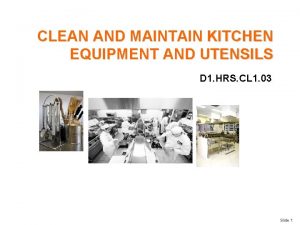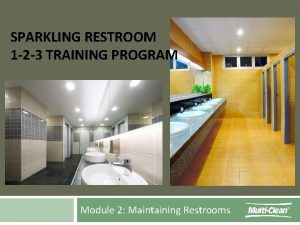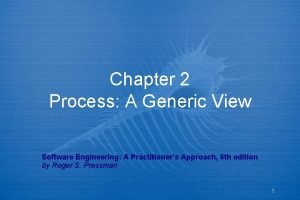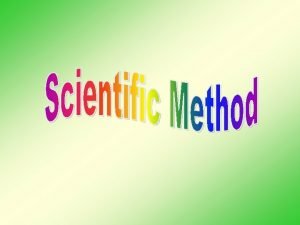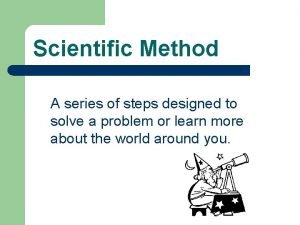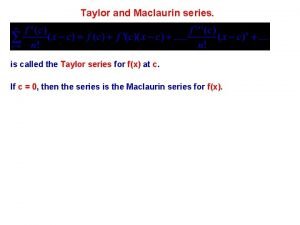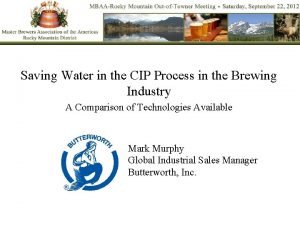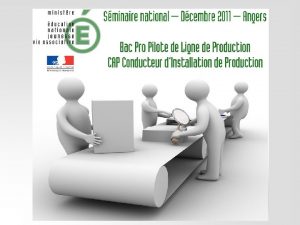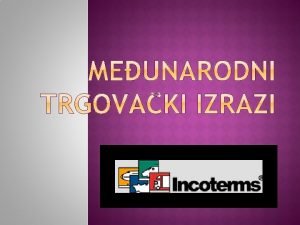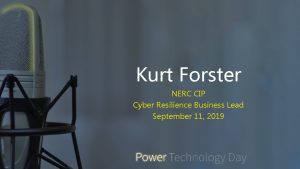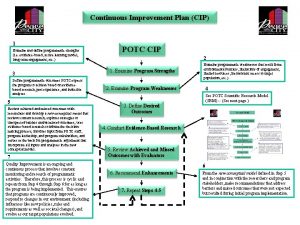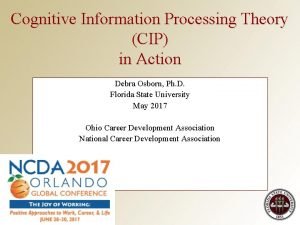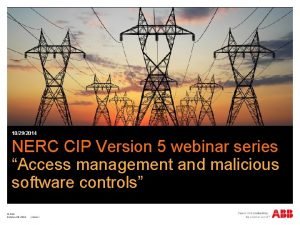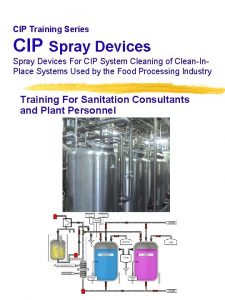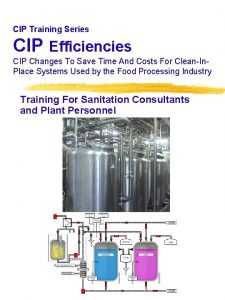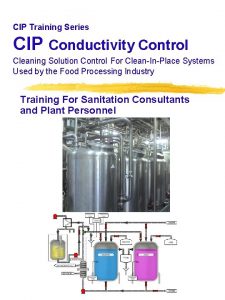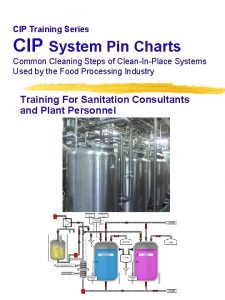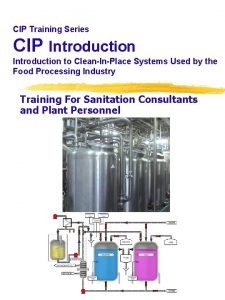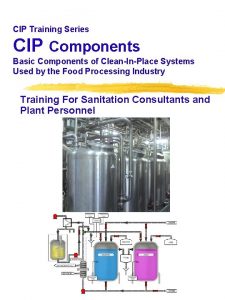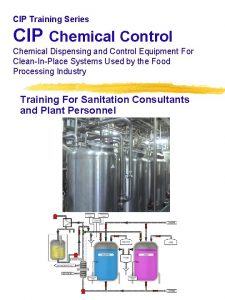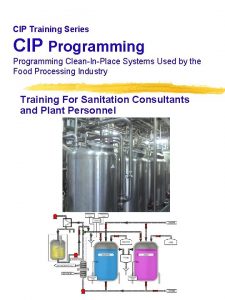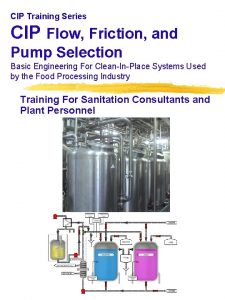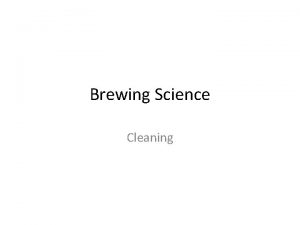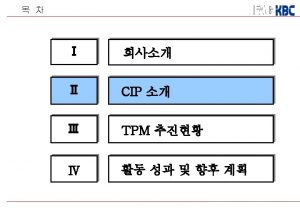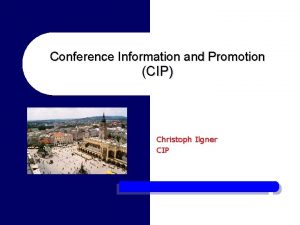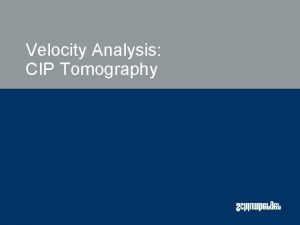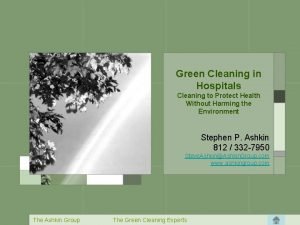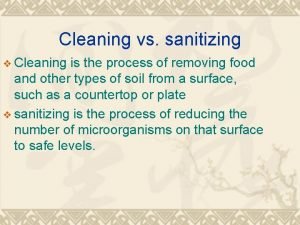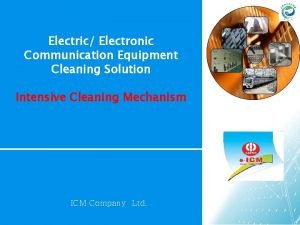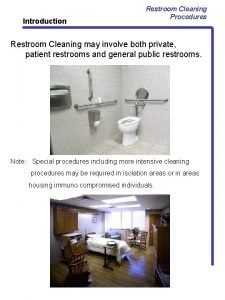CIP Training Series CIP Cycle Steps Common Cleaning















![CIP Program Air Blow or Chase Rinse [Refer to slides 11, 12] z. Minimizes CIP Program Air Blow or Chase Rinse [Refer to slides 11, 12] z. Minimizes](https://slidetodoc.com/presentation_image_h2/aafd66e326479de3e2378deb02e0ebb2/image-16.jpg)

















- Slides: 33

CIP Training Series CIP Cycle Steps Common Cleaning Steps of Clean-In-Place Systems Used by the Food Processing Industry Training For Sanitation Consultants and Plant Personnel

Know Your Soil z Raw or Cooked/Heated z Heavy or Light z Does it contain fat, protein, mineral or a combination y Heated food product generally has a higher level of mineral soil (milkstone, eggstone, beerstone, etc. ) y Heated soils may be thicker on the surface to be cleaned y Heated soils may be denatured and more tenacious

Know Your Soil z CIP Concentrations Depend on the Processing Equipment

Know Your Soil z Example of Pie Sauce Mix Tank y Soil has high carbohydrate content y Unheated Picture courtesy of Tim Bowser, Ph. D Oklahoma State University.

Know the Principles of Cleaning Four Variables of Cleaning z Chemical Solution Concentration z Contact time z Temperature z Mechanical Action y Applied by Flow -- pump hp (horsepower) and Sprayballs y Mechanical action is supplied in the form of Agitation/Flow Velocity/Pressure An increase or decrease in one variable must be Solution met by an Concentration increase or decrease in one or more Temperature (other) variables to “fill the cleaning wheel” (to achieve sufficient cleaning results). Wash Time Mechanical Action Flow - Pressure Example: Decrease wash Time—then increase temperature or concentration to achieve proper cleaning results.

Typical CIP Cleaning Steps z z z z Pre-rinse Air Blow or Chase Rinse Alkaline Wash Air Blow or Chase Rinse Post rinse (Recovery) Air Blow or Chase Rinse Acid Wash/Acidified Rinse y Can possibly be eliminated by using a acid sanitizer (depends on equipment and soil) z z z Air Blow or Chase Rinse Post Rinse Air Blow or nothing Sanitize Air Blow or nothing Each of these steps will be reviewed in greater detail in the subsequent slides.

CIP Program Pre-Rinse Step z Very important Step y Removal of large amounts of loose soils y Removal of gross soil first prolongs the life of the cleaning solution y A warm prerinse aids in tempering surfaces prior to the introduction of hot cleaning solutions z Use fresh water (softened city), COW, or RO permeate (RO Polished) z Temperature requirements y 100 -110°F typically: For most soils warm water is more effective for soil removal than a cold rinse; especially on fatty soils y May be controlled by steam valve to heat exchanger based on RTD of CIP supply z Rinse water source must have a volume sufficient to meet the requirements of the supply pump z Flow Velocity y Rule of thumb minimum of 5 ft/sec as a starting point. Larger diameter lines may require >10 ft/sec. (3 A Standards)

CIP Program Pre-Rinse Step z Burst rinsing [Burst rinsing is usually several bursts of rinse water as opposed to a continuous rinse. The programmed time for the first burst may be longer than the others in order to fill the line. ] - Burst rinsing with pump back step is most efficient for tanks/silos. - Each burst is often 15 -30 seconds in duration. - Several burst rinses followed by drainage (pump downs—pump out of tank bottom) are more effective than a single continuous rinse, as the soil is flushed to bottom of the vessel and removed from the tank or silo. - 2 -3 Burst rinses are common for tanks and process vessels - Continuous rinses may leave soils that float on the surface of the rinse solution that may not be removed (whereas bursts followed by pump downs or pump outs are more effective). - Continuous rinses remove soluble soils slowly by dilution. - Line circuits are not burst rinsed.

CIP Program Pre-Rinse Step Cont. z Rinse Recovery [Rinse Recovery saves and reuses the rinse water. It is used in the next pre-rinse, thus conserving water. ] - Rinse Recovery is most frequently used for the purpose of the next CIP cycles pre-rinse (or, it may be used for food product recovery to be used in manufactured product – such as a fat recovery system in the dairy). - In order to utilize rinse recovery, a storage tank is required (such as an additional tank as part of the CIP system). - Frequently the rinse is saved following the alkaline wash (after the alkaline CIP tank high level probe is satisfied, the solution is diverted to recovery CIP tank) - Post-rinses (typically the alkaline post-rinse) can also be saved. - If additional rinse capacity is needed than what is available in the rinse recovery tank, the system will switch over to fresh water, COW, or permeate.

CIP Program Pre-Rinse Step Cont. z Return Check [The primary purpose of the return check is to prevent rinse water and/or cleaning solution from accidently going into an open circuit, which could contain food product, causing contamination. ] - Return of the rinse (or other circulated solution) is done by activating a probe in the return line. - The return check works by having a probe in the return line sense the flow of rinse water or cleaning solutions. (If the return flow is sensed, the cycle moves forward. If no return flow is indicated, the system will shut down and signal an error or alarm. ) - Use a return check especially for the pre-rinse to prevent cleaning chemicals from mistakenly going into a circuit that is connected to it by error (that may contain food product or may be open and potentially causing injury).

CIP Program Air Blow or Chase Rinse [At the end of the rinse step or wash step there is usually either an air blow or a chase rinse. During rinse or wash steps the return pump (if there is one) or the return solution from CIP supply goes to either a tank or the drain. At the end of the cycle the system returns as much water or solution as possible, but it cannot empty the line completely. The air blow or chase rinse pushes the remaining solution in the line to either a CIP tank or to the drain. ] z. Air blow is injected into the piping circuit (after the CIP supply pump) to blow solutions in lines to help facilitate evacuation/draining. Prevents dilution of the wash solution. y Air blow works by having a check ball (rubber-coated SS or Teflon) plug the line; an air blow pushes the ball, opening the valve, pushing the remaining solution through the line. There also spring-check valves.

CIP Program Air Blow or Chase Rinse Continued z Chase rinse does the same thing as the air blow but by a different method. y y Chase rinse is best when controlled by conductivity. When the conductivity probe senses a change in cleaner concentration it diverts the solution. Example: If there is a holdup volume in the return line then the next rinse or the wash solution is used to push the residual solution back to the drain or tank. The remaining solution is then diverted to the proper tank/drain. z Air blows are less effective with long runs of large diameter pipe or where valve clusters are involved. z Most often the drain valve is normally open, so no activation is required. y Safety Feature: Valves sometimes fail to open; if the drain is normally open the rinse water will automatically go to the drain rather than to the CIP balance tanks. z For tanks, a drain step is needed to pump out the rinse water/soil to the drain. The tank outlet valve (and perhaps the return pump) are activated. z When using air blows the air source must be sanitary. y Requires clean/dry air source with 1 micron filters recommended—so that the sanitation program is not jeopardized z A programmed drain step must remove all rinse water or it will dilute the wash solution.

CIP Program Alkaline Wash Step [The pre-rinse removes most of the loose soil; the wash step removes the residual more-difficult soils. ] z Cleaner breaks down, suspends and removes alkaline-soluble soils (protein, fat, etc. ) z. Correct cleaner concentration must be met and maintained during the entire wash cycle y Cleaners are dosed into the system by a small dispensing pump that is controlled by either timed chemical addition or by conductivity probes. Conductivity is preferred for consistency and accuracy. y Conductivity is controlled by in-line probes on the supply side (or in the wash tank). In-line is preferred since the probes will be self-cleaned effectively. y Very beneficial to also have conductivity probes on the return side piping to minimize chemical overfeed. (These can be read-only or have control capability. ) y Step timer should go into hold when the set point is not met z. Temperature of wash step is determined by the detergent used and soil type y Chlorinated alkaline detergent (Tank 135 -150°F, Line 150160°F) y Caustic cleaner/alkaline detergent (Tank 135 -150°F, Line 150185°F) z. Minimum velocity for the line size must be met z. Minimum step time (Tanks 10 -20 min. , Lines 20 -30 min. per line run)

CIP Program Wash Step Cont. z CIP tanks are drained/recharged with fresh water (and chemical) whenever it becomes heavily soiled. y The cleaning solution can only suspend a certain level of soil and then it will precipitate/redeposit. z Delay to Temperature [Temperature is one of the four cleaning factors; cleaning results will be negatively affected if the temperature is too low. ] y The controller puts the program timer in hold mode until the setpoint temperature is reached. The wash time then begins to time out. Time at temperature is critical to good cleaning results. y Time to achieve temperature is a function of wash volume, initial water temperature, steam pressure, type of heat exchanger, and temperature of equipment/piping to be heated, and temperature loss of the equipment y A delay is important to achieve proper temperatures due to all the variables

CIP Program Wash Step Cont. z The PLC controls the Steam On and Steam Off Controls - The heating system and controls are activated by the PLC. The steam valve is open or closed based on the solution temperature and the setpoint in the controller. - The chemicals may or may not be added prior to steam - Steam valve opens too inject steam to a heat exchanger or direct to the CIP tank solution - The steam valve is controlled by an RTD (Resistance Temperature Device) or a thermostat to maintain the temperature at a setpoint level - The steam may be shut off prior the end of the wash to prevent overheating and energy waste z Circulation (Alkaline or Acid) - Solution from either the alkaline or acid CIP tank is recirculated through the equipment and CIP supply and return lines. The wash tank supply and return valves are activated for the open circulation loop.
![CIP Program Air Blow or Chase Rinse Refer to slides 11 12 z Minimizes CIP Program Air Blow or Chase Rinse [Refer to slides 11, 12] z. Minimizes](https://slidetodoc.com/presentation_image_h2/aafd66e326479de3e2378deb02e0ebb2/image-16.jpg)
CIP Program Air Blow or Chase Rinse [Refer to slides 11, 12] z. Minimizes loss of the wash solution z. Shortens the post-rinse step z. Chase rinse is best when controlled by conductivity in routing of solutions to the wash tank, to the rinse recovery tank (if present), or to the drain z. Long runs of large diameter pipe or valve clusters cause air blows to be less effective—design appropriately y Air blows may be completely ineffective on some circuits

CIP Program Alkaline Post Rinse [The purpose of the post-rinse is for removal of residual chemical, along with any soil that was dissolved or suspended during the wash step. ] z. Most efficient when conductivity controlled y The conductivity probe senses when the residual cleaner is removed adequately so “over-rinsing” is not done. This reduces and economizes the volume of water used. z. May be potable, COW, RO permeate, or rinse recovery (must be potable if no acid was is done and it is also the final rinse). z. Returned to the recovery tank on re-use systems to be used for the pre-rinse step on the next circuit y Recovery solution is reclaimed wash solutions of last CIP cycle and/or post rinses (often post-rinse of alkaline solutions used) y The advantage of reclaiming this rinse is that it has heat content/energy (BTUs) and may contain some residual alkalinity (to assist cleaning in the pre-rinse). Thus, water, heat, and residual chemical is recovered. z. For tanks/silos burst rinsing best and most efficient (typically a 20% reduction in water use) z. Rinse temperature 110 -120°F. Rinse helps cool equipment. Water at too cold of a temperature can

Air Blow or Chase Rinse [Same comments as prior slides. Residual rinse water either divert to drain or to rinse recovery tank. ] z. Prevents dilution of the acid solution (next step) z. Chase rinse is best when controlled by conductivity, especially after a wash step Alternative Method z. Some plants conduct an air blow on the alkaline or acid wash solutions; which is followed by a rinse. It is diverted to the CIP tank or drain depending on inline conductivity setpoints. y Conductivity higher than the setpoint is routed to the CIP tanks y Conductivity lower than the setpoint is routed to the drain

CIP Program Acid Wash/Acidified Rinse z Removes mineral deposits z Also an acid step neutralizes any remaining alkaline residue (if strong caustic alkali is used in the alkaline CIP tank) z Can sometimes be eliminated with the use of a Chlorinated alkaline wash step and the use of an acid sanitizer z Temperature should be less than 130°F (on nonheated food surfaces). z Some plants – if they get a mineral film on equipment – will run an acid cycle periodically (e. g. , weekly or monthly).

CIP Program Air Blow or Chase Rinse z Prevents loss of the acid solution z Shortens the post rinse step z Optimally controlled by conductivity

CIP Program Acid Post Rinse z Removal of acidity, along with any mineral soil that was dissolved or suspended (such as organic soil tied up with the mineral) during the acid rinse step. z Most efficient when conductivity controlled z Burst rinsing best and most efficient (typically about a 20% reduction in water use) z For vessels, burst rinsing with pump back (pump down) step is most efficient

CIP Program Sanitize Step [Cleaning steps remove soils and most microorganisms, but there may still be a few bacteria on the equipment] z. Final step prior to equipment startup for processing z. Reduces surviving bacteria from washing, rinsing, and draining of tanks, silos, equipment, lines, and valves (sanitizing defined as 99. 999% or 5 logarithmic reduction in 30 sec. on stainless hard surface) - but have at least 2 minute contact z. Most of the time a PLC activates a sanitizer pump during the sanitize step. z. The feed rate of the sanitizer is in the proper ratio to the flow rate of the CIP supply pump. y Often there is a needle valve on the sanitizer injection line. (It is used to calibrate the sanitizer dosage rate to be proportional to the flow. ) y Sometimes a variety of equipment is CIP’d on a given CIP system, each having different flowrates. This can pose a problem for sanitizer calibration. y More than one sanitizer pump may be needed to match the pump dispensing rate to the water flowrate.

CIP Program Sanitize Step Continued z Sanitizer is dispensed at the end of the final rinse. It is not rinsed but is allowed to drain/air dry. y May be rinsed in pharmaceutical manufacturing (to avoid residues). z Timed step long enough to fill the line or ~50 gal with air blow. Or, �~80 gal without air blow for a si y The sanitize cycle is often 15 -30 sec for tankers, 25 -45 sec for silos, and depending on the line circuit, 15 -20 seconds up to several minutes. y Proper programmed sanitizer injection times may be higher for long, large diameter piping circuits. z To minimize costs of expensive sanitizers the entire line is normally not filled with a sanitizing solution, instead a “slug” of solution in the line may be dosed with sanitizer, which then receives an air blow to push it through the spray ball or the line circuit. y This may not be effective for very long lines. z Some plants recirculate the sanitizing solution. This ensures complete/thorough coverage of equipment for a longer contact time, ensuring a 5 log kill. y A PLC can program valve functions/pulsing. A supply pump (lines) with a return pump (silos or equipment) allows circulation. (Greater solution volumes are needed. )

Manual Clean Items [In addition to CIP, some parts of the equipment may need manually cleaning. ] z. Exteriors z. Gaskets z. Manway Doors z. Sight Glasses z. Some types of agitators z. Air agitation units z. Petcocks and sample ports and valves z. PDP pump parts – some PDPs are CIPable. y Alternatively, there may be a swing pipe to bypass the PDP, or, the impellers may be removed and then the PDP is circulated with a CIP system circuit. z. Tank protrusions z. Dead ends z. Manual Plug valves

Chart Recorders z Important part of CIP system z Legal document and requirement y If USDA or FDA inspects your plant they will want to review the CIP charts – they are documentation of your cleaning program z “If you didn’t document it, you didn’t clean it” z Document in ink only z Things to be documented y y y y Date and operator’s initials Wash step temperature target Wash step target time Wash step target flow pressure or GPM Wash conductivity target if applicable All action steps relating to deviations Stamps are handy z The operators need to know y y How to change out the chart paper How to change out the recorder ink pens How to read the chart The Wash step targets

Chart Recorders Continued z Cleaning charts are an excellent trouble shooting tool; it is probably the first thing to check if there are cleaning problems. y Example: If cleaning temperatures are low… x Can indicate low steam pressure, faulty steam valves, faulty RTD, etc. y Example: If CIP pressures are low… x Can indicate faulty supply pump, inadequate solution volume, faulty valves, leaks in system, etc. z Circle charts are most common. There also strip charts and PLCs can record onto disks, etc. There is a variety of chart documentation equipment available. z Occasionally food plants can do a poor job of documentation. Equipment may not be identified, operators may not initial the charts, cleaner concentrations are not written down, and the charts maybe not even be replaced every day. z Good plant management is needed to manage charts and give direction to employees on proper rules to follow.

Concentration Testing z Must be done on a regular basis to verify the accuracy of the chemical addition z We recommend testing cleaner/sanitizer concentrations at least once per shift (at a minimum) for each CIP system. z May have a food company requirement z Provides a history for trouble shooting -catches sanitation problems sooner rather than later z Provides “Proof of Clean” y Concentrations are recorded on log sheets. y Many food safety programs require that their sanitation program is followed by having on file proper documentation. z Testing results in correction actions -- chemical waste reduction if found to be excessive, or, improved sanitation if found to be too low

System Checks [Checks are done on a CIP system to ensure CIP components are in good condition and functioning properly. ] z. Proof of Clean – visual by operator after every CIP circuit z. Flow Velocity – Semi-Annual z. Valves – Semi-Annual z. Spray Devices – Bi-Weekly z. CIP Check Balls – Quarterly z. Gaskets – Visual Daily for leaks (PM replaced Semi-Annual) z. Strainers – Weekly z. Pump seals – Visual Daily for leaks (PM replace Quarterly) z. Chemical control system – Quarterly (Recommend test concentrations Daily) z. Temperature control system – Monitor Daily (Calibrated Annually) z. Plug checks – Semi-Annually (These are only recommendations and may vary. )

Addressing CIP Cleaning Issues [Check the CIP program against what is actually happening. To ensure that everything is functioning properly. ] z Check the cleaning logs and recording charts to help diagnose problems early z Look at the last 3 months of charts z Verify the temperature control system is working correctly z Verify the level controls are working correctly z Verify the chemical addition is working correctly z Verify the rinses are adequate y Pre-rinse removing the large loose soils y Post rinses not allowing the chemicals to be neutralized x Example: Alkaline post-rinse not neutralizing the acid wash or neutralizing an acid sanitizing solution

Addressing CIP Cleaning Issues [If a cleaning problem develops, ask the question -- Was there a change in the product or process? ] z Adequate programmed CIP time for circuits with multiple line runs? z Inspection program up to date? z Are the valves pulsing correctly and enough? z Check valve seat condition y Poor condition leads to microbial issues z Are plug valves being removed and manually cleaned? z Correct type of valve being used?

Addressing CIP Cleaning Issues z Is there a pattern to the soil? Check for plugged spray balls. Picture courtesy of Tim Bowser, Ph. D. Univ. of Oklahoma z Is the spray device adequate for the application? z Is the pump sized for the spray device to deliver the correct gpm/pressure? z Is the spray device positioned correctly? z Is the spray device allowing correct sheeting action? z Is the pump sized to deliver the proper flow velocity? z Is there pump cavitation or a level control problem (e. g. , flooded suction)? z Air eliminators working?

Addressing CIP Cleaning Issues z Leaks on the suction side of the pump y How to tell? There are leaks from joints (under pressure) when the pump isn’t running. z Pump shaft seals leaking y Leaks from the pump shaft when the pump isn’t running. z Are strainers in place and not plugged – this can reduce solution flowrates z CIP check ball condition – If the wash balance tank overflows when the solution returns it could indicate that the check ball isn’t working, so that the rinse water isn’t being evacuated z Return lines below the supply lines and sloped toward the system z Return pump 20 in. (minimum) below the tank outlet z Return system balanced (Bath tub ring) z Are the manual clean areas being addressed and cleaned properly z Are there bypass loops around PDP’s z Have tanks been incorporated into line circuits z Are the correct chemicals/sanitizer being used for the soil type and application

CIP Training Thank you for your time! Questions?
 Maintaining kitchen tools and equipment
Maintaining kitchen tools and equipment Training design example
Training design example Restroom cleaning training
Restroom cleaning training Maclaurin series vs taylor series
Maclaurin series vs taylor series Heisenberg 1925 paper
Heisenberg 1925 paper Taylor series of composite functions
Taylor series of composite functions Taylor frederick
Taylor frederick Ibm p series server
Ibm p series server Shunt series feedback
Shunt series feedback Series aiding and series opposing
Series aiding and series opposing Sum of infinite series
Sum of infinite series A generic view of process in software engineering
A generic view of process in software engineering Involves a series of steps
Involves a series of steps A series of steps designed to solve a problem
A series of steps designed to solve a problem Common maclaurin series
Common maclaurin series Common mclaurin series
Common mclaurin series Which of the following is also known as axial movement?
Which of the following is also known as axial movement? Find the common multiples of 12 and 18
Find the common multiples of 12 and 18 Common anode and common cathode
Common anode and common cathode Common factors and common multiples
Common factors and common multiples What are the factors for 54
What are the factors for 54 Common factors of 12 and 42
Common factors of 12 and 42 Multiples of 9 and 21
Multiples of 9 and 21 Nerc cip v4
Nerc cip v4 How to use less water in cip
How to use less water in cip Rc cip
Rc cip Dap paritet
Dap paritet Kurt forster
Kurt forster Cip continuous improvement program
Cip continuous improvement program Cognitive information processing pyramid
Cognitive information processing pyramid Cognitive information processing theory
Cognitive information processing theory Cip pyramid
Cip pyramid Nerc cip webinar
Nerc cip webinar Cip modellen
Cip modellen
